|
|
|
Sort Order |
|
|
|
Items / Page
|
|
|
|
|
|
|
| Srl | Item |
| 1 |
ID:
139689


|
|
|
|
|
| Summary/Abstract |
Previous researchers have noted that the telegraph had a significant impact on late Qing politics in a variety of ways. This paper, however, argues that the telegraph in China failed to become a popular means of communication due to technical problems and misguided pricing policies. The Telegraph Administration (Zhongguo dianbaoju) was established in 1882, and its service suffered from persistent problems with regard to speed, stability, cost, and security. In order to keep profits up so as to be able to pay dividends to its shareholders, the Telegraph Administration did not invest in the latest and most efficient telegraph machines which would have enabled it to improve its service, cut down on telegraph fees, and attract more customers. Instead, it had to keep charges high for both private and commercial telegraph users, but at the same time it was not able to resolve delays in transmission, even for government messages. Although the service had an impact on the overall communications market in China—not least due to its near-monopoly position—and returned a degree of profit to its shareholders, the mindset of its administration and its approach to management limited the company's ability to develop a successful niche in the market or to achieve its potential as a driving force in China's economic development.
|
|
|
|
|
|
|
|
|
|
|
|
|
|
|
|
| 2 |
ID:
139686
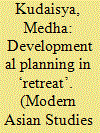

|
|
|
|
|
| Summary/Abstract |
This article concerns the history of economic planning in India in the late 1960s, when a vigorous debate took place on the institutions, instruments, and ‘personnel’ of developmental planning. Examining the years from 1967 to 1971, this article shows how dramatic attempts were made by warring politicians with the help of technocrats to decentralize economic planning, grant states more fiscal autonomy, and drastically reduce the powers of the Planning Commission. This article examines how these critical economic initiatives unfolded but were ultimately overshadowed by political power struggles in which the planning process and the Planning Commission became important tools in attempts for centralization.
|
|
|
|
|
|
|
|
|
|
|
|
|
|
|
|
| 3 |
ID:
139687


|
|
|
|
|
| Summary/Abstract |
Some Hindus are killing animals in larger numbers, more regularly, and in more spectacular fashions than they have ever done before. In contradiction of the ethnographic record asserting the diminishing significance of ritual killing since the nineteenth century, sacrifices to tutelary deities that had long been abandoned are being reactivated or enacted for the first time. However, such a counter-intuitive surge in the popularity of sacrifices is occurring at a time when the very deities to whom they are dedicated are apparently losing their potency. This seeming paradox, this article proposes, is an implication of both the entrenchment of electoral democracy and the material transformations accompanying economic liberalization in rural Tamil Nadu. In an electoral democracy, the political significance of tutelary deities—and consequently their charisma—has diminished. Their productive valence however, as exemplified in ritual sacrifices, has become ever more resonant in India's post-liberalization milieu, with its heightened sense of opportunity but also competitiveness and uncertainty.
|
|
|
|
|
|
|
|
|
|
|
|
|
|
|
|
| 4 |
ID:
139685
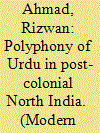

|
|
|
|
|
| Summary/Abstract |
Many scholars, politicians, and the lay people alike believe that Urdu in North India symbolizes a Muslim identity and culture. Based on an eight-month long ethnographic study and quantitative language data collected in Old Delhi, this article challenges this notion and shows that the symbolic meanings of Urdu have been mutating in post-colonial India. A cross-generational study involving both Muslims and Hindus shows that different generations assign different meanings to Urdu. Unlike the older generation, Muslim youth do not identify themselves with Urdu. A study of the Urdu sounds /f/, /z/, /kh/, /gh/, and /q/ in the speech of Muslim youth further demonstrates that they are losing three of these sounds. Another transformation involves the adoption of the Devanagari script to write Urdu by many Muslims. This change in the literacy practices of Muslims reinforces the shift in the symbolic meanings of Urdu. I argue that the transformation in the symbolic meanings of Urdu is reflective and constitutive of the sociopolitical changes that Muslims have undergone in the twentieth century.
|
|
|
|
|
|
|
|
|
|
|
|
|
|
|
|
| 5 |
ID:
139684


|
|
|
|
|
| Summary/Abstract |
In India in the 1860s, print was becoming the primary medium for the reproduction of religious texts. The accessibility of print, and its ready uptake within a highly stratified and competitive religious landscape, had a significant effect on the ways in which groups contended for textual, and thus spiritual, authority. In 1867, the popular Tamil Shaiva mystic Ramalinga Adigal and his followers published Tiruvarutpa, a book of Ramalinga's poems that would help establish his reputation as a great Shaiva saint. Ramalinga and his disciples chose to publish the work in a form that shared the content and the material features of contemporaneous publications of Tamil classics, thereby claiming a place for his poems alongside the revered Shaiva canon. They showed an acute awareness that it was not solely the content of religious texts, but also the materiality of the printed object in which texts appeared, that sustained assertions for authority. This article argues that leaders on the margins of established centres of religious power in South India sought authority by exploiting the material aspects of print as the new medium of religious canons.
|
|
|
|
|
|
|
|
|
|
|
|
|
|
|
|
| 6 |
ID:
139691
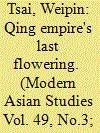

|
|
|
|
|
| Summary/Abstract |
The Great Qing Imperial Post Office was set up in 1896, soon after the First Sino-Japanese War. It provided the first national postal service for the general public in the whole of Chinese history, and was a symbol of China's increasing engagement with the rest of the globe. Much of the preparation for the launch was carried out by the high-ranking foreign staff of the Chinese Maritime Customs Service, an influential institution established after the first Opium War.
With a mission to promote modernization and project Qing power, the Imperial Post Office was established with a centrally controlled set of unified methods and procedures, and its success was rooted in integration with the new railway network, a strategy at the heart of its ambitious plans for expansion. This article explores the history of this postal expansion through railways, the use of which allowed its creators to plan networks in an integrated way—from urban centres on the coasts and great rivers through to China's interior.
|
|
|
|
|
|
|
|
|
|
|
|
|
|
|
|
| 7 |
ID:
139683
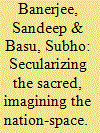

|
|
|
|
|
| Summary/Abstract |
This article examines changing conceptions of the Himalaya in nineteenth-century Bengali travelogues from that of a sacred space to a spatial metaphor of a putative nation-space. It examines sections of Devendranath Tagore's autobiography, written around 1856–58, before discussing the travelogues of Jaladhar Sen and Ramananda Bharati from the closing years of the nineteenth century. The article argues that for Tagore the mountains are the ‘holy lands of Brahma’, while Sen and Bharati depict the Himalaya with a political slant and secularize the space of Hindu sacred geography. It contends that this process of secularization posits Hinduism as the civil religion of India. The article further argues that the later writers make a distinction between the idea of a ‘homeland’ and a ‘nation’. Unlike in Europe, where the ideas of homeland and nation overlap, these writers imagined the Indian nation-space as one that encompassed diverse ethno-linguistic homelands. It contends that the putative nation-space articulates the hegemony of the Anglo-vernacular middle classes, that is, English educated, upper caste, male Hindus where women, non-Hindus, and the labouring classes are marginalized.
|
|
|
|
|
|
|
|
|
|
|
|
|
|
|
|
| 8 |
ID:
139690
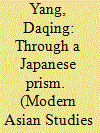

|
|
|
|
|
| Summary/Abstract |
This paper examines the key modern infrastructure of telecommunications in early Republican China, through the eyes of a Japanese, Nakayama Ryûji, who served as a telecommunications adviser to the Chinese government from 1913 to 1928. Nakayama's numerous reports and recommendations to his Chinese employer and frequent confidential dispatches to the Japanese government, when read together, constitute a fascinating prism. They not only reveal problems as well as the potential in China's telecommunications sector, they also highlight Japan's efforts to compete with other foreign actors in China through the provision of Japanese equipment, expertise, and loans. While Nakayama strove to shape China's telecommunications development in ways that would, in his view, benefit both China and Japan, his efforts were often undercut by the aggressive actions of the Japanese government in China, such as the infamous Twenty-One Demands. Though promising at first, Japan's influence on China's modernization in the early Republican era came to be more limited, especially when compared with the final decade of the Qing Dynasty. Ultimately, what can be seen through this Japanese prism confirms that the development of an information infrastructure in modern China, as elsewhere, was as much shaped by technological and economic forces as it was influenced by political and diplomatic factors.
|
|
|
|
|
|
|
|
|
|
|
|
|
|
|
|
| 9 |
ID:
139688
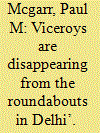

|
|
|
|
|
| Summary/Abstract |
In the aftermath of the Second World War, as post-colonial regimes in Africa and Asia hauled down imperial iconography, to the surprise and approval of many Western observers, India evidenced little interest in sweeping away remnants of its colonial heritage. From the late 1950s onwards, however, calls for the removal of British imperial statuary from India's public spaces came to represent an increasingly important component in a broader dialogue between central and state governments, political parties, the media, and the wider public on the legacy of British colonialism in the subcontinent. This article examines the responses of the ruling Congress Party and the British government, between 1947 and 1970, to escalating pressure from within India to replace British statuary with monuments celebrating Indian nationalism. In doing so, it highlights the significant scope that existed for non-state actors in India and the United Kingdom with a stake in the cultural politics of decolonization to disrupt the smooth running of bilateral relations, and, in Britain's case, to undermine increasingly tenuous claims of continued global relevance. Post-war British governments believed that the United Kingdom's relationship with India could be leveraged, at least in part, to offset the nation's waning international prestige. In fact, as the fate of British statuary in India makes clear, this proved to be at least as problematic and flawed a strategy in the two decades after 1947 as it had been in those before.
|
|
|
|
|
|
|
|
|
|
|
|
|
|
|
|
|
|
|
|
|